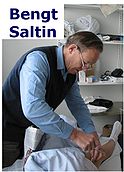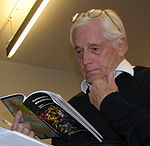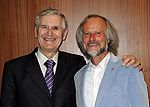Difference between revisions of "Gentle Science"
| Line 74: | Line 74: | ||
=== Literature === | === Literature === | ||
* [http://www.stard-statement.org/ STARD] checklist for the reporting of studies of diagnostic accuracy (2003) [http://www.stard-statement.org/pdf%20and%20word%20documents/Checklist.PDF pdf] | |||
* Ioannidis JPA (2005) Why most published research findings are false. PLoS Med 2(8):e124 - [[Ioannidis 2005 PLoS Med |»Bioblast link«]]. | * Ioannidis JPA (2005) Why most published research findings are false. PLoS Med 2(8):e124 - [[Ioannidis 2005 PLoS Med |»Bioblast link«]]. | ||
* Research: increasing value, reducing waste. [http://www.thelancet.com/series/research The Lancet (2014)] | * Research: increasing value, reducing waste. [http://www.thelancet.com/series/research The Lancet (2014)] | ||
* Ioannidis JP, Greenland S, Hlatky MA, Khoury MJ, Macleod MR, Moher D, Schulz KF, Tibshirani R (2014) Increasing value and reducing waste in research design, conduct, and analysis. Lancet 383:166-75. - [[Ioannidis 2014 Lancet |»Bioblast link«]]. | |||
* Begley CG, Ioannidis JP (2015) Reproducibility in science: improving the standard for basic and preclinical research. Circ Res 116:116-26. - [[Begley_2015_Circ_Res |»Bioblast link«]] | * Begley CG, Ioannidis JP (2015) Reproducibility in science: improving the standard for basic and preclinical research. Circ Res 116:116-26. - [[Begley_2015_Circ_Res |»Bioblast link«]] | ||
* Horton R (2015) Offline: What is medicine’s 5 sigma? [http://www.thelancet.com/pdfs/journals/lancet/PIIS0140-6736%2815%2960696-1.pdf The Lancet 385:1380] | * Horton R (2015) Offline: What is medicine’s 5 sigma? [http://www.thelancet.com/pdfs/journals/lancet/PIIS0140-6736%2815%2960696-1.pdf The Lancet 385:1380] | ||
Revision as of 15:39, 5 September 2015
- Gentle Science recognizes the responsibility of the scientific community
- - for the quality of science, the quality of life in science, and its mission
While the individual scientist contributes her/his share, the scientific community requires concerted actions (see MitoGlobal) to encourage Gentle Science on institutional, national and world-wide levels [Note 1a,b].
Gentle Science Certificate
Which of your previously attended conferences would you award with a Gentle Science Certificate? Here is a brief checklist:
- Exciting scientific programme balanced between overview lectures and hot topics.
- Balance of invited and selected lectures given by senior scientists and young investigators.
- Programme and conference setting help to communicate beyond the formal scientific schedule and stimulate networking.
- Gender balance for chairpersons.
- Gender balance for lecturers.
- Prices for accomodation sufficiently low (the upper limit per night including breakfast might be 120-140 €), not to cut into the conference budget (costs for invited speakers), to keep the overall expenses for attendees low.
- Poster sessions organized for good attendance (not just in coffee/tea breaks, to allow for communication beyond poster viewing).
- Transparent conference budget, promoting the attendance of scientists from less priviliged countries and students.
- Open information on registration and abstract submission deadlines.
This list needs to be improved, extended, and specified accurately. Quantitative criteria need to be defined objectively (costs, balances). The 'Gentle Science Certificate' may help scientists in their decision to accept or decline invitations, for attendees to register at a more gentle conference, and for sponsors to support Gentle Science Events.
Bengt Saltin - a great Gentle Scientist
03.06.1935 - 12.09.2014
The scientific community is deeply saddened by the loss of a great scientist, a Gentle Scientist and friend.
In order to honour and commemorate the scientific work of Prof Bengt Saltin, The Saltin Symposium 2015 was held in Copenhagen, Denmark, celebrating his 80th birthday. Gentle Science is explained by the scientific achievements and the life of Bengt Saltin.
Bioenergetics - Art meets Gentle Science
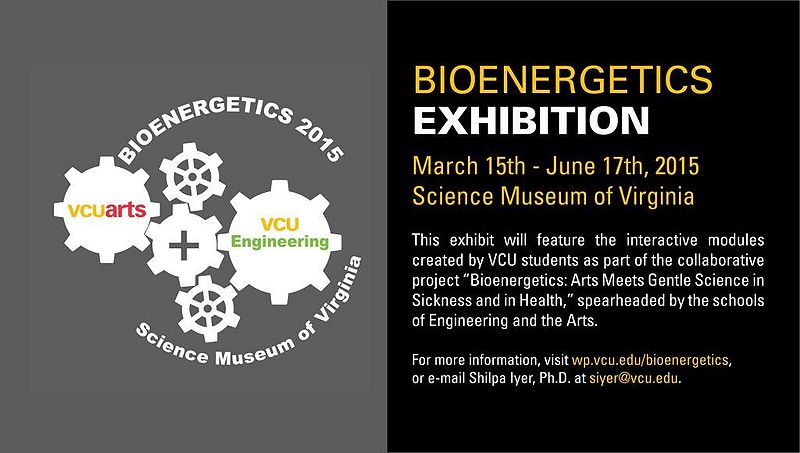
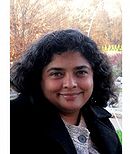 Bioenergetics Exhibition - Art meets Gentle Science
Bioenergetics Exhibition - Art meets Gentle Science
- A Gentle Science project initiated by Shilpa Iyer. More information: Iyer S, Faris S, Rao R, Jamison R, Maurakis E: MiP2014 Abstract.
- Shilpa Iyer proposed the term ‘Gentle Science’ at a dinner following an OROBOROS workshop in Innsbruck, Dec 2009. And the response was clear and explicit: Gentle Science Shapes the World.
The Vancouver Protocol, ICMJE, and Gentle Science
It is fair to say that the Vancouver Protocol carries the spirit of Gentle Science, as further developed and updated in the 'Recommendations for the Conduct, Reporting, Editing, and Publication of Scholarly Work in Medical Journals' by the International Committee of Medical Journal Editors (ICMJE). Do all involved editors (SI units), most authors and peer reviewers know that? Responsible scientist can add more Gentle Science into science and society by complying to these recommendations.
The following points are direct quotes from [1], [2]. "This document is not covered by copyright: it may be copied or reprinted without permission". For an update see [3] [Note 2a]. The quoted points are a selection of topics with direct implications on Gentle Science. The selection is not intended to be complete or exclusive, but is meant to motivate further reading, discussion and action in the spirit of Gentle Science:
- Prior and duplicate publication: When submitting a paper an author should always make a full statement to the editor about all submissions and previous reports that might be regarded as prior or duplicate publication of the same or very similar work.
- Authorship: Each author should have participated sufficiently in the work to take public responsibility for the content. .. Participation solely in the acquisition of funding or the collection of data does not justify authorship. General supervision of the research group is also not sufficient for authorship. Any part of an article critical to its main conclusions must be the responsibility of at least one author. [Note 2b,c]
- Methods: Identify the methods, apparatus (manufacturer's name and address in parentheses), and procedures in sufficient detail to allow other workers to reproduce the results. Give references to established methods.
- Statistics: Give details about randomization. Describe the methods for and success of any blinding of observations.
- Acknowledgments: One or more statements should specify (a) contributions that need acknowledging but do not justify authorship, such as general support by a departmental chairman; (b) acknowledgments of technical help; (c) acknowledgments of financial and material support, specifying the nature of the support; (d) financial relationships that may pose a conflict of interest.
- Units of measurement: All hematologic and clinical-chemistry measurements should be reported in the metric system in terms of the International System of Units (SI).
References
- ↑ Uniform requirements for manuscripts submitted to biomedical journals. International Committee of Medical Journal Editors. BMJ : British Medical Journal 1991;302:338-41. »Open Access
- ↑ International Committee of Medical Journal Editors. Uniform requirements for manuscripts submitted to biomedical journals. N Engl J Med 1991; 324:424-8. »Open Access
- ↑ International Committee of Medical Journal Editors [www.icmje.org/icmje-recommendations.pdf]. Recommendations for the Conduct, Reporting, Editing and Publication of Scholarly Work in Medical Journals. Updated Dec 2014 [2015-01-06] Available from: http://www.ICMJE.org.
On the radar of Gentle Science
Organizations
- PubMed Commons - "'From repositories to blogs, the web has expanded means to share information and resources widely. PubMed Commons members are tying data, code, and more back to publications by adding external links to PubMed records.'"
- European Network of Research Integrity Offices
- EQUATOR network: Enhancing the QUAlity and Transparency Of health Research
- The EQUATOR Network is an international initiative that seeks to improve the reliability and value of published health research by promoting transparent, accurate and complete reporting. The EQUATOR website provides a central repository of up-to-date reporting guidelines and other resources assisting in a preparation of good research manuscript (www.equator-network.org).
- Responsible reporting of research studies, which includes a complete, transparent, accurate and timely account of what was done and what was found during a research study, is an integral part of good research and publication practice and not an optional extra.
- The EQUATOR team collates resources facilitating the reporting of health research, provides education about the available guidelines, and supports the development of new reporting guidelines. A recommendation is to tncorporate an explicit philosophy of transparent and accurate reporting and the use of reporting guidelines. The EQUATOR Network has initiated work on methodological guidance for developers of reporting guidelines, investigation of barriers and facilitators to implementing reporting guidelines within journals, and on creating a tool for the critical appraisal of available reporting guidelines. The results of these projects should facilitate the process of identifying which guidelines are suitable to be supported by a journal.
Literature
- STARD checklist for the reporting of studies of diagnostic accuracy (2003) pdf
- Ioannidis JPA (2005) Why most published research findings are false. PLoS Med 2(8):e124 - »Bioblast link«.
- Research: increasing value, reducing waste. The Lancet (2014)
- Ioannidis JP, Greenland S, Hlatky MA, Khoury MJ, Macleod MR, Moher D, Schulz KF, Tibshirani R (2014) Increasing value and reducing waste in research design, conduct, and analysis. Lancet 383:166-75. - »Bioblast link«.
- Begley CG, Ioannidis JP (2015) Reproducibility in science: improving the standard for basic and preclinical research. Circ Res 116:116-26. - »Bioblast link«
- Horton R (2015) Offline: What is medicine’s 5 sigma? The Lancet 385:1380
- Yordanov Y, Dechartres A, Porcher R, Boutron I, Altman DG, Ravaud P (2015) Avoidable waste of research related to inadequate methods in clinical trials. BMJ 350:h809
Bioblast Conference
Bioblast 2012 (Innsbruck, 2012-Dec-10 to 12) was organized in the spirit of Gentle Science.
- Gnaiger E (2012) Gentle Science and the Bioblast Conference. Mitochondr Physiol Network 17.12.
- Kliemt U, Gnaiger E (2012) Power and efficiency: Tempo giusto in classical music, thermodynamics and industrial revolution, and the speed of life. Mitochondr Physiol Network 17.12.
- Iyer S (2012) Gentle Science in the real world of mitochondrial physiology and genetics. Mitochondr Physiol Network 17.12.
- The link to the 2-minute video can be found at http://youtu.be/9hgrvgAP934. Please share it with others Shilpa Iyer.
Sir John Walker - Honorary Gentle Science Member of MiP
Nobel laureate Sir John Walker (Cambridge MBU, UK; Nobel prize 1997 in chemistry) has joined the MiPsociety as the first 'Honorary Gentle Science Member' of the Mitochondrial Physiology Society, following his presentation of 'The ATP Synthase' at the MiPsummer School 2012 on July 10 in Trinity Hall, Cambridge.
From fierce competition to Gentle Science
Gottfried Schatz published a book on the history of bioenergetics, from a personal point of view with a broad perspective on post-war science in general and mitochondrial bioenergetics in particular. The classical period of bioenergetics, culminating in the Nobel Price for Chemistry awarded to Peter Mitchell in 1978, is well known for not only fiercly competitive but personally aggressive disputes. The book 'Feuersucher - Die Jagd nach dem Geheimnis der Lebensenergie' by Gottfried Schatz (2011) could have another subtitle: The emergence of Gentle Science. See Open Access article: [1].
QA and Gentle Science
At the dinner following the summary session of the QA Workshop on ‘Respirometry of Permeabilized Muscle Fibres: Towards Quality Assurance in the Diagnosis of Mitochondrial Function’ (2009 December 9-12; Innsbruck, Austria), the discussion turned to the limited degree of freedom available in our world of competitive science to implement quality rather than quantity in the publication strategies of scientists. We are all fighting with the overload of new publications, many of which lack the quality that would be desirable in the spirit of true progress. What would be an alternative? Are we catering for Fast Food (i.e. frequently junc food) in science? Do we need a Slow Food (Slow Science) movement? Then Shilpa Iyer proposed ‘Gentle Science’, and the response was clear and explicit: Gentle Science Shapes the World, signed by all participants at the dinner discussion (see Signatures; the table napkin was donated by the restaurant ‘Glasmalerei’; several workshop participants had to leave the QA workshop before the summary discussion)..
Discussion
General discussion on Gentle Science
-> Continue the discussion: Talk:Gentle Science
Open access publication
- The topic of Open access publication should be taken into serious consideration by Gentle Science.
-> Continue the discussion: Open Access
Network
- Several initiatives contribute to a science in the spirit of 'Gentle Science'.
-> We welcome further contacts in the Gentle Science Network.
Quotes
- For first steps, see: 'powerful, efficient, and more gentle ..'.
- Open science - Open access - Open innovation [Note 3a,b].
- Unexamined science is not worth practicing/publishing.
- Gentle Science develops and implements the concept of Scientific Social Responsibility (SSR), complementary to Corporate Social Responsibility (CSR). Combine large scientific footprints with small environmental footprints; implement strategies of sustainability: climate change in the laboratory [Note 3c]
- Gender balance at all levels.
- Young scientists balance.
- Gentle Science aims at quality that should not be compromised for the sake of quantity, speed, or ‚first to publish’. From maximization to optimization [Note 3d]
- Gentle Science implements Better Practice and Quality Assurance explicitly.
- Gentle Science supports new approaches, making possible an evolutionary improvement of the quality of scientific publications, for fair science, fair citation, … [Note 3e]
Notes
Notes 1
- (1a) Does Gentle Science require a form of organization? – non-profit organization? – Gentle Science homepage? – Gentle Science network, linked on homepages – Gentle Science statements on homepages, Email signatures, letterheads – Encourage scientific societies and journals to engage in Gentle Science.
- (1b) How can the scientific community provide positive feedback to the practice of Gentle Science, rather than supporting junk science (unfair citation hiding the priority of other groups; incomplete methods description, not disclosing important detail to potential competitors; presentation merely of published information at conferences, preventing open exchange on cutting-edge scientific progress; quick-and-dirty publication instead of implementation of QA, compromising quality for the sake of apparent priority; …)?
Notes 2
- (2a) Quote: 'The ICMJE encourages wide dissemination of these recommendations and reproduction of this document in its entirety for educational, not-for-profit purposes without regard for copyright, but all uses of the recommendations and document should direct readers to www.icmje.org for the official, most recent version, as the ICMJE updates the recommendations periodically when new issues arise.' [2015-01-06] Available from: http://www.ICMJE.org.
- (2b) Why authorship matters: 'Authorship confers credit and has important academic, social, and financial implications. Authorship also implies responsibility and accountability for published work. The following recommendations are intended to ensure that contributors who have made substantive intellectual contributions to a paper are given credit as authors, but also that contributors credited as authors understand their role in taking responsibility and being accountable for what is published.' [2015-01-06] Available from: http://www.ICMJE.org.
- (2c) Who is an author: 'The ICMJE recommends that authorship be based on the following 4 criteria:
- Substantial contributions to the conception or design of the work; or the acquisition, analysis, or interpretation of data for the work; AND
- Drafting the work or revising it critically for important intellectual content; AND
- Final approval of the version to be published; AND
- Agreement to be accountable for all aspects of the work in ensuring that questions related to the accuracy or integrity of any part of the work are appropriately investigated and resolved.
- In addition to being accountable for the parts of the work he or she has done, an author should be able to identify which co-authors are responsible for specific other parts of the work. In addition, authors should have confidence in the integrity of the contributions of their co-authors.
- All those designated as authors should meet all four criteria for authorship, and all who meet the four criteria should be identified as authors. Those who do not meet all four criteria should be acknowledged—see Section II.A.3 below. These authorship criteria are intended to reserve the status of authorship for those who deserve credit and can take responsibility for the work. The criteria are not intended for use as a means to disqualify colleagues from authorship who otherwise meet authorship criteria by denying them the opportunity to meet criterion #s 2 or 3. Therefore, all individuals who meet the first criterion should have the opportunity to participate in the review, drafting, and final approval of the manuscript.' [2015-01-06] Available from: http://www.ICMJE.org.
Notes 3
- (3a) Published scientific information – largely supported by the society - should be accessible in general, without separation of privileged ‘rich’ institutions and limited access in underdeveloped countries. Open access and open-source initiatives should be supported.
- (3b) Provide information on the specific responsibilities of each co-author in all publications: While an increasing number of journals requests author information, inclusion of this information should constitute a decision and responsibility of the authors even in cases when this information is not requested (for comparison, less important statements are found frequently in the acknowledgements section).
- (3c) Climate change in the laboratory: Unnecessary waste production can be limited in scientific institutions, by implementation of energy-efficient and material-efficient technologies. Dischargeable tools should be replaced by application of re-usable tools whenever possible. Scientific institutions should be rated on the basis of their positive scientific impact and their positive environmental impact factor.
- (3d) Optimization instead of maximization is required in strategies of scientific publication. While scientific output is still rated frequently on a totally non-scientific basis of ‘number’ of publications, simple mechanisms may be implemented by the scientific community to encourage quality rather than quantity. In job applications and project applications, for instance, a personal selection of very few ‘high quality and relevant’ publications should be requested, without further consideration of numbers of scientific publications (what are large numbers good for?).
- (3e) Evolution of a scientific publication: Even when trying the best in completion of a publication, there is generally scope for making it better. Whereas a printed ‘paper’ is a final document of an original publication, any published pdf file can potentially be edited for further improving the quality of a publication (corrections, additions, re-interpretations, even short discussions). For instance, fair citation may not always be possible in the most optimal way, given the constraints on page limits, maximum number of references, and the impossibility of complete awareness by the authors of further relevant references. Additions, corrections and extensions are possible, however, in the form of supplementary materials that may be added even after publication, particularly on the basis of correspondence that may be initiated only after publication. If journals do not include supplementary materials after publication, this may be achieved by institutional or other homepages etc., where sections are linked to the relevant publications. Corrections and additions may then not be limited to ‘fair citations', but be extended to all other relevant supplementary information, which may be more useful and efficient than a ‘new’ publication.

